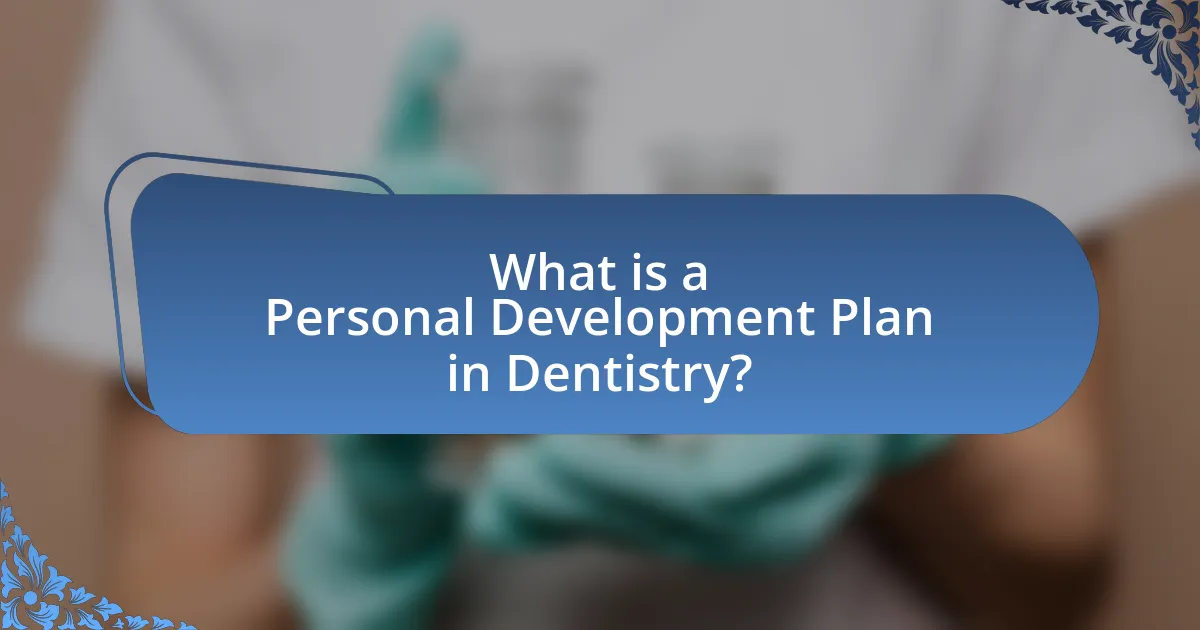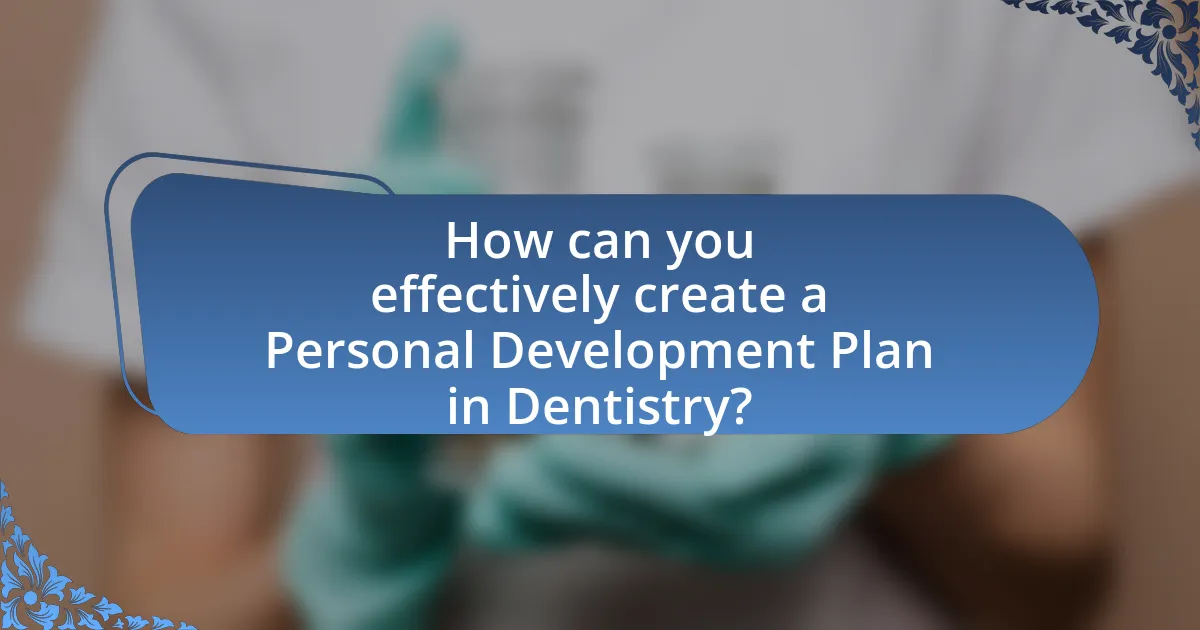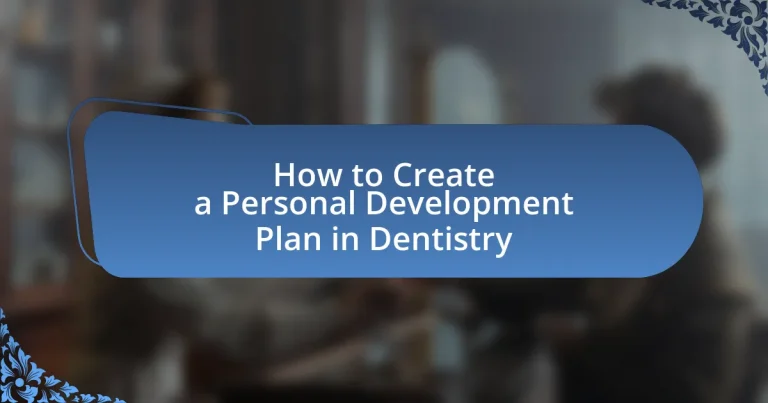A Personal Development Plan (PDP) in dentistry is a structured framework that dental professionals utilize to identify career goals, assess skills, and pinpoint areas for improvement. This article outlines the benefits of a PDP, including enhanced job satisfaction and improved patient outcomes, while detailing its key components such as self-assessment, goal setting, action planning, and evaluation. It also discusses strategies for creating and implementing an effective PDP, the importance of mentorship and networking, and common challenges faced during the planning process. By following best practices and regularly reviewing progress, dental professionals can align their development plans with their career aspirations and adapt to the evolving demands of the industry.

What is a Personal Development Plan in Dentistry?
A Personal Development Plan in Dentistry is a structured framework that dental professionals use to identify their career goals, skills, and areas for improvement. This plan typically includes specific objectives related to clinical skills, patient management, and professional growth, allowing dentists to enhance their competencies and adapt to evolving industry standards. Evidence shows that implementing a Personal Development Plan can lead to improved job satisfaction and better patient outcomes, as it encourages continuous learning and self-assessment within the dental field.
How does a Personal Development Plan benefit dental professionals?
A Personal Development Plan (PDP) benefits dental professionals by providing a structured framework for continuous learning and skill enhancement. This structured approach allows dental professionals to identify specific goals, assess their current competencies, and outline actionable steps to achieve desired outcomes. Research indicates that professionals who engage in personal development are more likely to experience career advancement and job satisfaction, as they actively pursue relevant training and education opportunities. Furthermore, a PDP encourages self-reflection, enabling dental professionals to adapt to evolving industry standards and patient needs, ultimately improving the quality of care they provide.
What are the key components of a Personal Development Plan in dentistry?
The key components of a Personal Development Plan in dentistry include self-assessment, goal setting, action planning, and evaluation. Self-assessment involves identifying strengths, weaknesses, and areas for improvement in clinical skills and knowledge. Goal setting establishes specific, measurable, achievable, relevant, and time-bound (SMART) objectives tailored to professional growth. Action planning outlines the steps and resources needed to achieve these goals, such as attending workshops or pursuing further education. Evaluation is the process of reviewing progress towards goals, allowing for adjustments to the plan as necessary. These components ensure a structured approach to continuous professional development in the dental field.
How can a Personal Development Plan enhance career growth in dentistry?
A Personal Development Plan (PDP) can enhance career growth in dentistry by providing a structured framework for setting and achieving professional goals. This plan allows dental professionals to identify specific skills and competencies they need to develop, such as advanced clinical techniques or business management skills. By regularly assessing their progress and adjusting their goals, dentists can stay aligned with industry advancements and patient care standards. Research indicates that professionals who engage in continuous learning and skill enhancement are more likely to experience career advancement and job satisfaction, as evidenced by a study published in the Journal of Dental Education, which found that 85% of dental professionals who utilized a PDP reported improved career outcomes.
Why is it important to create a Personal Development Plan in dentistry?
Creating a Personal Development Plan in dentistry is crucial for enhancing professional growth and ensuring continuous improvement in skills and knowledge. This structured approach allows dental professionals to set specific goals, identify areas for development, and track progress over time. Research indicates that professionals with clear development plans are more likely to achieve their career objectives and maintain high standards of patient care, as evidenced by a study published in the Journal of Dental Education, which found that 85% of dentists who implemented personal development plans reported increased job satisfaction and improved clinical outcomes.
What role does self-assessment play in developing a Personal Development Plan?
Self-assessment is crucial in developing a Personal Development Plan (PDP) as it enables individuals to evaluate their strengths, weaknesses, skills, and areas for improvement. This reflective process allows dental professionals to identify specific goals and tailor their development strategies accordingly. Research indicates that self-assessment enhances self-awareness, which is essential for setting realistic and achievable objectives in a PDP. For instance, a study published in the Journal of Dental Education highlights that self-assessment fosters critical thinking and promotes lifelong learning among dental practitioners, ultimately leading to improved patient care and professional growth.
How does a Personal Development Plan align with professional goals in dentistry?
A Personal Development Plan (PDP) aligns with professional goals in dentistry by providing a structured framework for setting, tracking, and achieving specific career objectives. This alignment is crucial as it allows dental professionals to identify areas for improvement, such as clinical skills or patient management, and create actionable steps to enhance their competencies. Research indicates that structured development plans lead to increased job satisfaction and performance, as they help practitioners focus on relevant skills and knowledge needed in the evolving dental field. For instance, a study published in the Journal of Dental Education highlights that dentists who engage in continuous professional development through structured plans are more likely to meet their career aspirations and improve patient care outcomes.

How can you effectively create a Personal Development Plan in Dentistry?
To effectively create a Personal Development Plan in Dentistry, begin by conducting a self-assessment to identify your strengths, weaknesses, and areas for improvement. This assessment should include evaluating your clinical skills, communication abilities, and knowledge of dental practices. Following the self-assessment, set specific, measurable, achievable, relevant, and time-bound (SMART) goals that align with your career aspirations, such as enhancing specific technical skills or pursuing advanced certifications.
Next, outline actionable steps to achieve these goals, which may involve enrolling in continuing education courses, attending workshops, or seeking mentorship from experienced professionals in the field. Regularly review and adjust your plan based on progress and changing career objectives, ensuring that it remains relevant and effective. Research indicates that structured personal development plans significantly enhance professional growth and job satisfaction in healthcare fields, including dentistry.
What steps should be followed to create a Personal Development Plan?
To create a Personal Development Plan, follow these steps: first, assess your current skills and identify areas for improvement. This involves reflecting on your strengths and weaknesses in the context of your dental practice. Next, set specific, measurable, achievable, relevant, and time-bound (SMART) goals that align with your career aspirations in dentistry. After establishing your goals, outline the necessary actions and resources required to achieve them, such as training programs, mentorship, or workshops. Then, create a timeline for completing these actions, ensuring to include regular check-ins to evaluate your progress. Finally, review and adjust your plan periodically to reflect any changes in your career objectives or personal circumstances. This structured approach is supported by research indicating that goal-setting and self-assessment are effective strategies for professional development in healthcare fields.
How do you conduct a self-assessment for your Personal Development Plan?
To conduct a self-assessment for your Personal Development Plan, begin by evaluating your current skills, strengths, and areas for improvement in the context of your dental practice. This involves reflecting on your clinical competencies, communication skills, and professional knowledge. Utilize tools such as self-reflection questionnaires or feedback from peers and mentors to gather insights. Research indicates that structured self-assessment can enhance professional growth; for instance, a study published in the Journal of Dental Education found that self-assessment practices significantly improve learning outcomes among dental students. By systematically identifying your developmental needs, you can create targeted goals that align with your career aspirations in dentistry.
What resources can assist in the creation of a Personal Development Plan?
Resources that can assist in the creation of a Personal Development Plan include professional development courses, mentorship programs, and self-assessment tools. Professional development courses, such as those offered by dental associations, provide structured learning opportunities that enhance skills relevant to dentistry. Mentorship programs connect individuals with experienced professionals who can offer guidance and insights tailored to career goals. Self-assessment tools, like SWOT analysis, help individuals identify strengths, weaknesses, opportunities, and threats, facilitating a clearer understanding of personal and professional growth areas. These resources collectively support the development of a comprehensive and actionable Personal Development Plan in the field of dentistry.
What common challenges might arise when creating a Personal Development Plan?
Common challenges that might arise when creating a Personal Development Plan include a lack of clarity in goals, difficulty in self-assessment, and insufficient resources for implementation. A lack of clarity can lead to vague objectives, making it hard to measure progress. Difficulty in self-assessment often results from an inability to accurately identify strengths and weaknesses, which can hinder effective planning. Insufficient resources, such as time, financial support, or access to training, can impede the execution of the plan. These challenges are frequently reported in studies on personal development, highlighting the importance of clear goal-setting, honest self-evaluation, and resource allocation for successful outcomes.
How can you overcome obstacles in the planning process?
To overcome obstacles in the planning process, identify potential challenges early and develop strategies to address them. For instance, conducting a SWOT analysis (Strengths, Weaknesses, Opportunities, Threats) can help pinpoint specific barriers in creating a personal development plan in dentistry. Research indicates that proactive planning significantly increases the likelihood of achieving goals; a study published in the Journal of Dental Education found that structured planning improves educational outcomes for dental students. By anticipating issues and preparing solutions, individuals can navigate the complexities of their development plans more effectively.
What strategies can help maintain motivation during the implementation of a Personal Development Plan?
To maintain motivation during the implementation of a Personal Development Plan, setting specific, measurable goals is essential. These goals provide clear targets and milestones, which can enhance focus and drive. Research indicates that individuals who set specific goals are more likely to achieve higher performance levels compared to those with vague objectives. Additionally, regularly reviewing progress and celebrating small achievements reinforces motivation by providing a sense of accomplishment. Studies show that positive reinforcement can significantly boost an individual’s commitment to their goals. Engaging in accountability partnerships, where progress is shared with peers or mentors, also fosters motivation, as social support can encourage persistence and commitment.

What are the best practices for implementing a Personal Development Plan in Dentistry?
The best practices for implementing a Personal Development Plan (PDP) in Dentistry include setting clear, measurable goals, regularly assessing progress, and seeking feedback from peers and mentors. Clear goals provide direction and motivation, while measurable outcomes allow for tracking advancements in skills and knowledge. Regular assessments, such as quarterly reviews, help identify areas for improvement and adjust the plan as necessary. Additionally, obtaining feedback from experienced colleagues can offer valuable insights and enhance professional growth. Research indicates that structured PDPs significantly improve career satisfaction and performance in healthcare professionals, including dentists.
How can you track progress on your Personal Development Plan?
To track progress on your Personal Development Plan, regularly review and assess your goals and milestones. This involves setting specific, measurable objectives and using tools such as journals or digital tracking apps to document achievements and setbacks. Research indicates that individuals who engage in consistent self-reflection and evaluation are more likely to achieve their developmental goals, as they can adjust their strategies based on real-time feedback.
What tools can be used to monitor your development in dentistry?
Tools that can be used to monitor development in dentistry include performance assessments, continuing education tracking systems, and peer review processes. Performance assessments provide measurable outcomes of clinical skills and patient care, while continuing education tracking systems help dental professionals log completed courses and certifications, ensuring they meet ongoing education requirements. Peer review processes facilitate constructive feedback from colleagues, enhancing professional growth and adherence to best practices. These tools collectively support dentists in evaluating their progress and identifying areas for improvement, ultimately contributing to their professional development.
How often should you review and update your Personal Development Plan?
You should review and update your Personal Development Plan at least once every six months. Regular reviews ensure that your goals remain relevant and aligned with your evolving career in dentistry. Research indicates that frequent assessments can enhance motivation and accountability, leading to more effective personal and professional growth.
What tips can enhance the effectiveness of a Personal Development Plan?
To enhance the effectiveness of a Personal Development Plan, individuals should set specific, measurable, achievable, relevant, and time-bound (SMART) goals. SMART goals provide clarity and direction, making it easier to track progress and stay motivated. Research indicates that individuals who set SMART goals are 33% more likely to achieve their objectives compared to those who do not use this framework. Additionally, regularly reviewing and adjusting the plan based on feedback and changing circumstances ensures that the plan remains relevant and effective. Engaging in continuous learning through workshops, courses, or mentorship can also significantly improve skills and knowledge, further contributing to the success of the Personal Development Plan.
How can networking contribute to your Personal Development Plan in dentistry?
Networking can significantly enhance your Personal Development Plan in dentistry by providing access to mentorship, collaboration opportunities, and industry insights. Engaging with professionals in the dental field allows for the exchange of knowledge and experiences, which can lead to improved clinical skills and business acumen. For instance, a study published in the Journal of Dental Education found that networking among dental professionals fosters a supportive community that encourages continuous learning and professional growth. This collaborative environment can also lead to referrals and partnerships, further expanding one’s practice and influence in the field.
What role does mentorship play in achieving your development goals?
Mentorship plays a crucial role in achieving development goals by providing guidance, support, and knowledge transfer from experienced individuals to less experienced mentees. In the context of dentistry, mentorship can enhance clinical skills, improve decision-making, and foster professional growth. Research indicates that mentorship relationships significantly increase job satisfaction and career advancement opportunities, as evidenced by a study published in the Journal of Dental Education, which found that 70% of dental professionals attribute their career success to effective mentorship. This relationship not only facilitates skill development but also helps in navigating the complexities of the dental profession, ultimately leading to more successful personal development plans.


